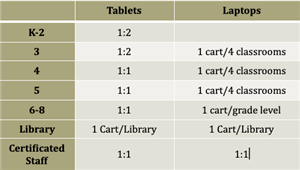- Mill Valley School District
- Overview
Technology
Page Navigation
-
Technology
The Mill Valley School District Technology Department is guided by the vision of providing students, staff, and the community with information technology resources and services that support learning, instruction, research, data collection, and administrative operations.Director of Education TechnologyKate Sprague ksprague@mvschools.orgDirector of Technology
Alec Barnhardt abarnhardt@mvschools.orgInstructional Technology CoachKatie Fisher kfisher@mvschools.orgSystems Administrators/Technicians:Eric Farrand, Yiming LuTechnology Strategic Plan
Program and Funding Overview
VISION:
The District aims to provide a rigorous and relevant instructional program delivered by high quality educators who use innovative, research-based strategies to enable students to participate in a global environment. It envisions students who are engaged in meaningful learning and teachers who serve as leaders and partners in their learning goals. Technology prepares students in our rapidly evolving world for the challenges of high school and beyond, and helps to build critical 21st century skills, such as communication, collaboration, creativity and critical thinking. The District is committed to providing teachers with these powerful tools and students with these critical learning opportunities. The broad goals of the Technology Strategic Plan involve coordinating efforts to increase equity and access to technology tools, and to provide effective professional development in the innovative use of those tools.
PURPOSE:
- Plan for and provide effective professional development (PD)
- Assure that there is equity of access throughout the district
- Coordinate and manage technology purchases
- Plan for regular replacement cycles
- Allow for more efficient support and equipment maintenance
- Establish a plan for infrastructure upgrades
TECHNOLOGY CONCERNS:
- A comprehensive technology assessment was performed that identified needs around network infrastructure, data systems, phone and bell systems and other equipment.
- An increase in the number of devices being used throughout the District has put a strain on the system.
- Consistency in access to devices, network and programs will encourage regular use by teachers in the instructional setting.
- Lack of a consistent device replacement cycle has made budgeting and acquiring up to date devices difficult.
- Increased use of online data and assessment systems has increased the need for devices and stability in the classrooms and throughout the school sites.
- A lack of standardization throughout the District when sites make their own purchases outside of the technology department.
IMPORTANT CONSIDERATIONS:
- Instructional Technology continues to be a high priority for the Mill Valley School District.
- Instructional Technology provides opportunities for student collaboration, communication, creativity, and critical thinking – important 21st Century skills
- Instructional Technology Coach continues to help assess needs and deliver timely training and PD
- Instruction in Digital Citizenship and Information Fluency will be included
- Textbooks are rapidly moving to a more powerful and engaging digital format
- 1:1 tablet program in grades 5-8 allows students more opportunity to take charge of their own learning and to explore authentic, real-word projects
- Annual review allows flexibility and will determine if goals are being met and if new technologies should be considered
- District funds teacher hardware, software/instructional materials, infrastructure, support, and PD

REFRESH CYCLES:
- Up-to-date devices are necessary for effective and efficient technology use
- Online testing, both state and local, require minimum hardware and system specifications
- Refresh cycles include iPads and laptops for classroom and teacher use, as well as devices for the English Language Development Department, Special Education Department, and Libraries
- Student iPads will be replaced on a four-year cycle, with the suitability of those devices assessed yearly
- Student laptops will be replaced on a five- to six-year cycle, with the flexibility to adjust for enrollment changes and technology needs
- Teacher laptops will be replaced on a four- to five-year cycle
- Teacher iPads will be replaced on a four-year cycle
ON-GOING SUPPORT:
- Professional development is provided by the Instructional Technology Coach throughout the school year
- Individual and team appointments with the Instructional Technology Coach, along with open Office Hours, are available for support and follow-up, including project planning or implementation
- Team-teaching and demonstration-teaching opportunities are available with the Instructional Technology Coach
- Utilizing video conferencing technology will allow continued and more frequent and flexible opportunities for teacher and staff support
- Teacher input is considered for future professional development topics and sessions
- Student support is offered via a dedicated support email address, and the timeliness of responses is assessed
- Additional student support offerings are being considered
INDICATORS OF SUCCESS:
- Increased stability in network services will allow for consistent and dependable use of technology in the classroom
- Increased and updated devices will allow students to perform multiple measures of assessment throughout the school year
- Reduction in non-district standard devices being purchased at the site levels
- Teachers are empowered to focus on high-level instruction as technology helps to manage and organize classroom data, and increases efficiency on administrative tasks
- Full integration of technology meets Common Core curriculum requirements
- Students have new ways to practice and demonstrate knowledge and mastery
- Students are empowered to take charge of their own learning with grade-appropriate tools
- Students can effectively and safely navigate the rapidly changing technological world
- All schools reach technology equipment ratio goals
- All five elementary schools achieve technology standardization
- Incoming 6th graders are well prepared for middle school with appropriate technology skills
- Academic performance data, teacher and student survey results, paperwork reduction figures, technology usage time, and/or adherence to budget are measured as data points to indicate progress
Previous Tech Plan Updates

